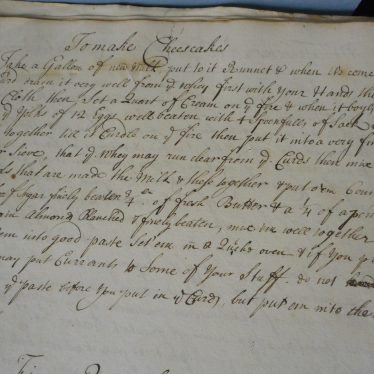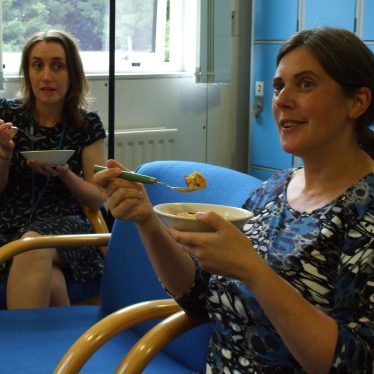The first archive recipe in the Heritage Cooking Challenge comes from one of Warwickshire County Record Office‘s most famous collections, the Waller Family papers. This collection includes the well-known recipe book belonging to Mary Wise but instructions for this cheesecake come from another book, written by different people and boasting 153 pages of recipes for food, drink and even medicines. The contents are dated between 1711 and 1731 and this recipe is for a fairly standard cheesecake of the time.
Recipes for cheesecakes have been around since the 15th century and were originally defined as a ‘cooked tart made from curd cheese with the addition of ingredients such as eggs, sugar and spices’.
These days we think of cheesecakes more as the baked or chilled cream cheese variety. This Wise family recipe more closely resembles the delicious Yorkshire curd tart.
How I did it
I started by making the cheese curds. I used non-homogenised gold top milk in an effort to replicate the ‘new milk’ called for by the recipe. It was pasteurised, but organic raw milk would have been the closest we have to the kind of milk available to cheesemakers in the 18th century.
Most milk available today is homogenised to spread the cream evenly through the milk, but older readers may remember the bottles of gold top left on the doorstep with the satisfyingly thick wodge of cream nestling at the top. This is the best kind of milk for cheesemaking as it sets more solidly once rennet is added.
Rennet is an enzyme found in a cow’s stomach which reacts with milk to coagulate it and separate out the fat solids. Famous cheesemakers Paxton and Whitfield suggest on their website that cheesemaking was discovered by accident in Sumeria, when milk carried in a shepherd’s leather bottle was curdled. Since then a bewildering variety of cheeses have been developed from the same starting point: milk, rennet (or other coagulant like lemon juice or vinegar) and a little salt. Hard cheeses require a starter culture and lots of time to ripen, but to make a simple curd cheese is easy and relatively quick.
The Wise family cooks would probably have dropped a section of cow’s stomach into their milk to curdle it, but in deference to vegetarian colleagues I used the synthetic version of rennet which is now widely available. I heated the milk to blood temperature and stuck my (clean) finger in to check as there would have been no thermometers available to 18th century cooks! Then I added the rennet. If the milk is too hot it kills the enzyme in the rennet and the curds don’t develop.
Curds and whey
After around 20 minutes, the milk solidified and I spooned the mixture into a clean muslin cloth. This hung from a cupboard door for 24 hours to drain they whey into a bowl. I didn’t need this for the recipe, but did not throw it away. I put it in the freezer to use the next time I make bread.
TIP: Bread made with whey instead of water has a soft texture and makes wonderful toast!
Once the curds were ready I boiled 500mls of organic double cream and added six egg yolks beaten with sweet sherry. The recipe calls for sack (which is no longer sold) but as sack was a fortified wine, I substituted some sweet sherry. I expected the eggs to scramble as soon as they hit the cream, but surprisingly they didn’t. The recipe asked me to separate this mix into curds as whey also, but as I didn’t have any I took a chance and mixed the curds into the cream anyway with the required powdered sugar and currants that I had opted to use. It looked OK!
Next I took a pack of butter and made a paste with the ground almonds. I made a decision early on to use ground almonds instead of trying to finely beat a pack of blanched almonds. I wasn’t sure I had the muscles for it.
Hot oven
I spread the paste into the baking bowls and put them into a ‘quick’ or hot oven for 10 minutes. They did not set hard but formed a solid layer that I could spoon the curd/cream mixture onto. After that I put both cakes into the oven and slowly turned it down over 40 minutes from 200o C to 160oC. When ovens weren’t so adjustable, cooks would bake bread in the oven when it was at its hottest, and then cook other dishes as it cooled, ending with cakes and biscuits as it cooled. It must have taken some skill to avoid the soggy or burnt bottoms in those days.
The cheesecake was generally well-received by our tasting panel although the mix was too rich for some palates and could perhaps have been sweeter. Why not have a go and let us know what you think? #vintagefood
Visit this page to find out a background to the project.










Comments
My parents can remember having something similar when they were young. Though these were made with a pastry base instead of butter and almonds, they still called it a cheesecake rather than a tart.
To make the cheesecake, they would use curds or beastlings as they were called from the milk of cows newly calved. So this was an occasional treat when the beastlings were available.
Milk was used instead of double cream and my mother’s family used rum instead of the sherry. The cheesecakes were given a dusting of nutmeg before they went into the oven.
I’ve got a cream attachment for the Kenwood I inherited too and I couldn’t get my head round it – using butter to make cream. Now though I’ve found it’s really freed up my imagination – using yoghurt, creme fraiche, soft cheese etc in quiche and pastries interchangeably with butter. Inspiration from the past – who can beat it.
An interesting texture, soft and creamy but rather bland for modern tastebuds.
A bit out of my comfort zone, a bit ‘woolly’ in texture, but not entirely unpleasant. Not a cheesecake as I know it however!
And the curd tart/cheesecake was delicious too – although the base wasn’t quite as crisp as I like it.
I’ve used short dated cottage cheese to make delicious curd tarts before now. Two benefits – lots of cottage cheese used up and it avoids the huge amount of effort involved in making your own. I’ll definitely add the sweet sherry in the future though. Genius idea.
My description in six words: Buttery biscuit base – but borderline bland!
(no offense Sharon, it was beautifully cooked, I just like a bit more oomph in my flavours ;p)
I thought this was excellent, even though I’m not a fan of cooked cheesecake. Tend to agree with Becky that it needed a touch more flavour. It could be the basis of something interesting.
I thought it tasted like baby food.
The texture was unlike other cheesecakes, but still very pleasant
Oh dear 🙁
I really wanted to like it – honestly. Unfortunately the texture was weird and the rest I have wiped from my memory!
Although this memory is not local, it probably represents other people’s experience. When I was a child in York in 1948-1955 (I don’t remember back right to the beginning of of this period) we had our milk delivered by the producer on his horse-drawn cart (as were our greens and bread). He had Jersey cows and the milk was wonderful. The milk was Tuberculin Tested (TT) but not pasteurised, and my mother used to boil it to protect me from whatever bugs might have been in there. The result was that there was a wonderful skin formed on the top which was very similar to clotted cream (though real clotted cream is not boiled). It was wonderful on a pudding or cereal.
Rice pudding, made by putting 2 tbsp of pudding rice into a Pyrex dish with a pint of milk with a little sugar was made in the oven on Reg 2 for the morning and created a pudding with a lovely brown creamy skin, traditionally fought over by the children. The milk came in wide mouthed bottles with a cardboard cap which had a smaller circle which you pushed out to lift it from the top. These cardboard caps were collected in schools and bound around with raffia to make table mats.
In 1954 we moved to Swansea where the milk was not Jersey, but was pasteurised. The bottles about then had the narrower necks with foil tops.
You could buy a device which was a rubber dome which fitted into the top of the milk bottle; a narrow tube descended into the cream at the top of the bottle and emerged at the side. You pressed down on the dome and the top of the milk was forced out of the tube into the cup or whatever that you put under it. Without homogenisation, the cream you extracted this way had enough fat that you could whip it to at least top a trifle. I never remember my mother buying cream in these years. You could also buy a device (I still have my grandmother’s) which you could use to emulsify whole milk with extra de-salted butter to make double cream.
It seems difficult to believe that cream was sufficiently expensive then to make all this fiddle possible (you even had to de-salt the butter as unsalted was not much available then, by melting it in hot water and floating the butter off the top). When I became the proud owner of a Kenwood Chef in 1973 I bought a cream-making attachment, the equivalent of the hand operated one I inherited from my Grandmother.
How times change!
I really relished eating this! Maybe it was because this was the first one I’d had and I was just excited by the concept…! But it really tasted its age, if that makes sense. It tasted like I imagined an 18th century cheesecake might taste. Probably just me being romantic! And it was quite British – stolid and creamy and comforting.
Add a comment about this page